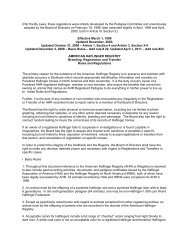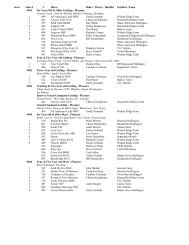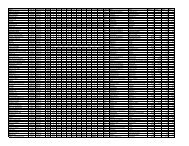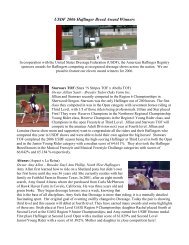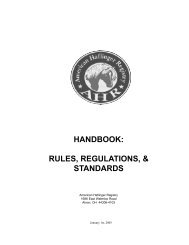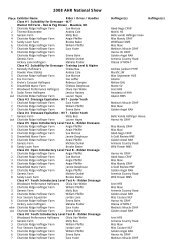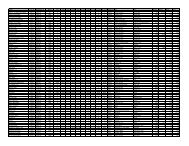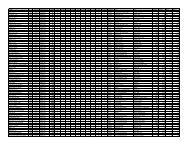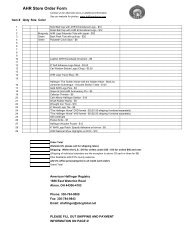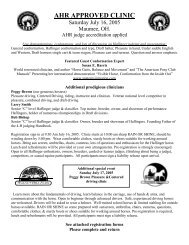Breeding Objectives Document - American Haflinger Registry
Breeding Objectives Document - American Haflinger Registry
Breeding Objectives Document - American Haflinger Registry
Create successful ePaper yourself
Turn your PDF publications into a flip-book with our unique Google optimized e-Paper software.
Page 1<strong>Breeding</strong> <strong>Objectives</strong> for the <strong>American</strong> <strong>Haflinger</strong> <strong>Registry</strong>This document shall serve as the breed standard for <strong>Haflinger</strong> horses registered with the<strong>American</strong> <strong>Haflinger</strong> <strong>Registry</strong>, and is to be used as reference for all <strong>Haflinger</strong> breed classes atshows and at breed inspections(Revised August 17, 2005)BREED:ORIGIN:DESCENT:EXTERNAL APPEARANCE:Color:<strong>Haflinger</strong> HorsesThe <strong>Haflinger</strong> breed was founded on the indigenous small horses of the Tyrolean Mountains’oriental half-blood 133 El`Bedavi XXII (1868) with the stallion 249 FolieAfter the stallion Folie, crossing with a horse from another breed is not permitted either onthe side of the stallion or the mare. Pure breeding is the primary guideline for the breedingobjectives of the <strong>American</strong> <strong>Haflinger</strong> <strong>Registry</strong>Color may range pale chestnut to dark liver chestnut with pale mane and tail. Colorimpurities in the base color, as in roaning, black spots etc. are undesirable and excessivedeviations will be judged as negative and strongly discouraged for breeding animals. Colorimpurities in the mane and tail are undesirable and excessive deviation from white or flaxenwill be judged as negative and strongly discouraged for breeding animals.Markings:Size:Type:Body structure:Head markings are desirable, but not a prerequisite, too many markings are undesirable andcan go as far as being strongly discouraged. Leg markings are not desirable: One white legwill not be penalized, two white legs will result in a one point deduction, three white legswill result in a two point deduction, and horses with four white legs or white above the kneesor hocks will be strongly discouraged from breeding. A white leg is a white sock that extendsabove the fetlock joint. White markings are signified by a change in skin pigment.The desired size is from 54 in. to 60 in. Non-achievement of the minimum size should resultin the horse being strongly discouraged from breeding. The maximum size may be exceededin the case of an excellent or outstanding exterior evaluation.A desirable appearance of the horse is one of elegance and harmony. To this belongs a leanand expressive head with large eyes, well formed neck and supple mid-section, a good croupnot too divided and not too short, a distinct musculature as well as correct, defined limbswith good joints. Stallions and mares for breeding should have clearly defined masculine orfeminine features.Undesirable is in particular a stout, plump non athletic appearance, a coarse head, unclearcontours, undefined joints, and coarse limbs as well as a lack of defined masculine orfeminine features.A harmonious body structure that is suitable for all-round pleasure horse.It should have the following qualities:1. The head should be noble and lean, the size in harmony with the horse, with largeforward pointing eyes and wide nostrils. The head should have enough poll freedom toallow for correct flexion, a clean connection of the head to neck through the jowl areaand correct positioning of the ears.2. The neck should be medium long and slimmer towards the head, with no bulky lowerline, not too wide and demonstrate good freedom of the lower jaw muscles.3. A pronounced withers reaching well into the back, large diagonally lying shoulders andsufficient depth of chest are the most striking distinguishing features of the forehand.4. The back should be medium long and muscular as well as displaying swinging, loadbearing capacity and balance in its movement.5. The hindquarters should have a long, slightly sloping but not too steep with a not tooobviously divided well-muscled croup. The tail should not be set too low.6. All in all a harmonious distribution of the forehand, mid-section and hindquarters is tobe aimed for.7. Front and hind limbs are extremely important and should have correct conformation andclearly pronounced joints, with a broad and flat knee-joint and a broad strong hock. Afull range of bone measurements proportionate to height shall be considered, withspecial attention to the quality of the cannon bone, as indicated by an oval shape, cleanconnection to both the fetlock and pastern joints, and clear definition of the tendons and
Page 2ligaments. Seen from the front and from behind limbs should show straightconformation, seen from the side a straight standing foreleg and hind leg angled atapproximately 150° at the hock as well as a hoof angle of approximately 45° to 55° tothe ground are desirable. The pasterns should be moderately long and well developed.The hooves should be round, distinct and hard.8. The stride should be correct, supple and of a pure rhythm without serious faults.9. The horse should have as good as possible long-reaching swinging stride at its disposalwith an elastic and not too flat gait, showing good impulsion from behind.10. In particular an excellent character without vices and an even temperament.Not Desirable is:1. A lack of harmony in the body structure and a lack of features defining masculinity orfemininity.2. A head that is coarse or too big, a Roman nose or even a too wide or too small head areundesirable. In compliance with AHR licensing requirements, faults of the mouth suchas parrot or monkey mouths will exclude stallions from being licensed. These faults inmares are strongly discouraged.3. In particular a short, heavy or deep-set neck structure.4. A small, steep shoulder, a short or less pronounced withers, or too little depth of chest.5. A back that is too short or overlong, or soft or too stiff. The loin coupling is of greatimportance: The longer the distance from the withers to the coupling, and/or the longerthe distance from the last rib to the point of hip, the weaker the back. A high “waist” aswell as narrowness from left to right sides over the loin coupling also indicatesweakness. Structural strain or breakdown is indicated by lumpiness in this area.6. A short or straight croup with a high set tail or a too broad and strongly divided croup.7. Incorrect limbs such as the following: small, slim or restricted joints, too weak or toomassive cannon bones and short, steep or too long or too soft pasterns as well as smallor too steep hooves, in particular with inwards or outwards directed frog as well as thefollowing conformations; pigeon toed, splay footed or knock-kneed or bow-legged frontlegs, narrow or wide at the hocks. Further undesirable are calf knees or bench knees,steep or sickle-hocked, cow-hocked or bandy-legged limb conformations.Movements: The basic gaits: Desirable are hard-working rhythmic and swinging basic gaits (Walk 4-time, trot 2-time, canter 3-time). The movements at a walk should be relaxed energetic andelevated. The movements at the trot and gallop should be supple, swinging, light on the feetwith a noticeable swinging phase and with a natural suspension. The clear thrust of the footfrom an active working hindquarter should be transferred over a loosely swinging back to theanticipating forehand moving freely from the shoulder. Some knee action is desirable. Inparticular the canter should demonstrate a clear forwards and upwards springing sequence.Undesirable are especially short, flat and non supple movements with a stiffly held back,heavy movements falling on the forehand or movements without rhythm as well as, pigeontoed,traveling wide, splay-footed movements, interference, brushing or rope-walking.INTERNAL CHARACTERISTICS/HEALTH:Desirable is a horse with a strong character, a good-natured, strong, all-round, eager and ableto perform, an easy feeder, resistant, easy to acclimatize, that is useful for all purposes. Inparticular this is valid for riding, driving and vaulting in the pleasure and sport sector, butalso as a working horse for pulling and carrying.<strong>Breeding</strong> Horse Classification:For recognition of the predisposition for performance the following features will beexamined:1. Character and temperament as observed by the judges during the inspection andmeasurement process.2. Conformation, shown standing in hand.3. Basic gaits (walk and trot) shown on the triangle4. Free schooling, including canter or gallopThe Classification of breeding horses aged 6 or over are final decisions, the judgments will not be revised up or downafterwards, however; an owner is entitled to one appeal and the opportunity to re-present the horse one time only at alater inspection under different judges. The decision at the second inspection will be final.The measurements for entry in classification records are typically taken at 3 years. These measurements correspond tothe minimum and maximum sizes laid down in the breeding objectives. Failure to attain the minimum height at 3 yearsmeans the animal will be strongly discouraged from breeding.




